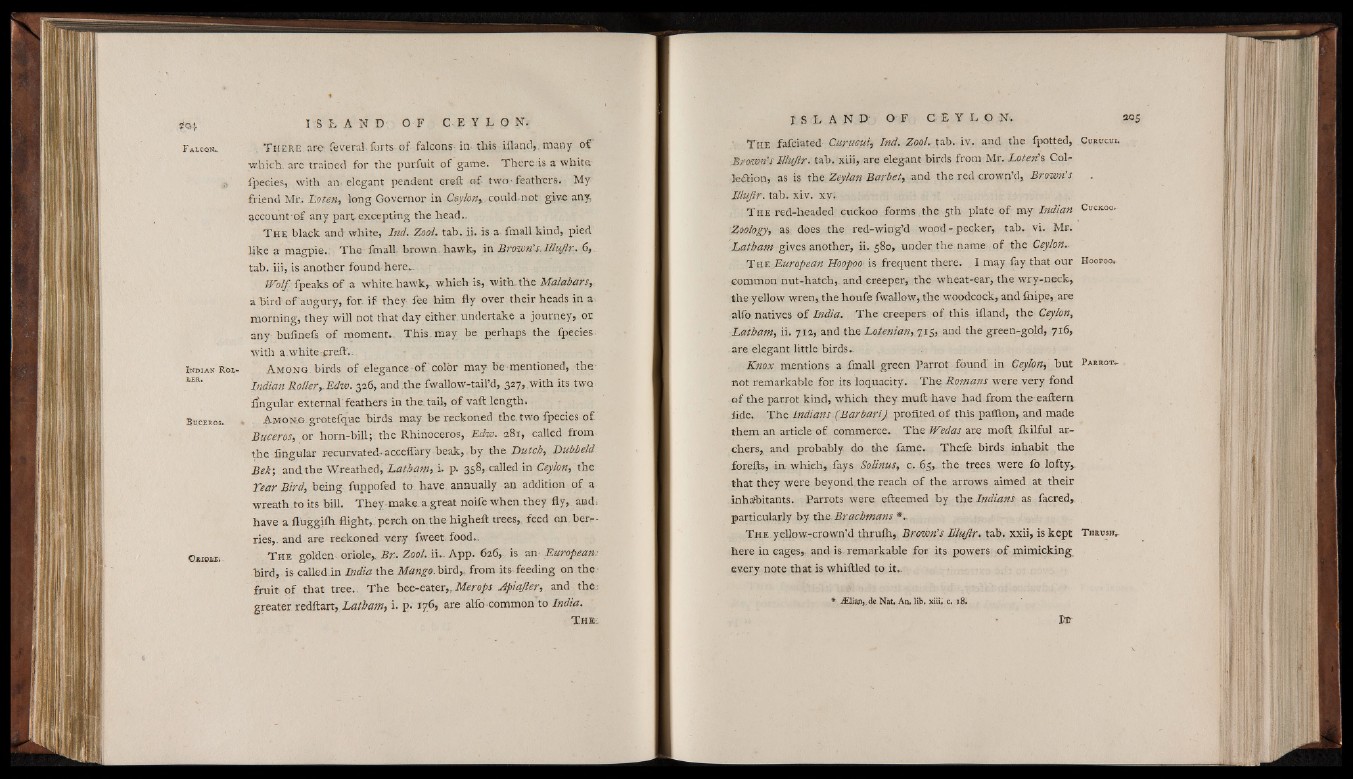
204
F ALCONA
I n d i a n RO L LER.
Bu.CES.OS»
OsiOtFi
Th e re , ar-e feveral. forts of falcons- in- this ifland, many of
which, are trained for the purfuit of game. There is a white
fpecies, with an-elegant pendent craft of- two - feathers. My
friend Mr. Loten, long Governor in Ceylon-, could.not give any
account o f any part excepting the head-
T h e black and white, Ind. Zoo-l. tab. ii. is a. fmall kind,, pied
like a magpie- The fmall. brown, hawk, in Brown's. Illujlr.. 6,
tab. iii, is another found here..
Wolf fpeaks o f a whitehawk,- whieh is, with-the Malabars,
a bird of'augury, for. i f they fee him fly over their heads in a.
morning, they will not that day either, undertake a journey, or
any-buiinefs o f moment- This may be perhaps the fpecies-
with a white-creft..
A m o n g b i r d s o f e le g a n c e o f c o lo r m a y b e m e n t io n e d , t h e
Indian RolleryEdw. 326, a n d t h e fw a l lo w - t a i l ’d , 327, w i t h it s tw o
A n g u la r e x t e r n a f f e a th e r s in th e . ta i l , o f v a f t l e n g t h .
Amon .g grotefqae birds may be reckoned the. two fpecies o f
Buceros, or horn-bill;.the Rhinoceros,. Edw. 281, called from
the lingular recurvated, acceflary beak, by the Dutch, Dubbeld
Bek; and the Wreathed, Latham, i. p. 358, called in Ceylon, the
Tear Bird, being, fuppofed to have, annually an addition of a
wreath to its hill. They-make a.great noife when they fly, and:
have a fluggilh flight,, perch on. the higheft trees,, feed on.berr-
ries,. and are reckoned very fweet, food-
T h e golden oriole,. Bn. Zool. ii- App. 626,, is an- European;
bird, is called in India the Mango.LvcA,. from its-feeding on the
fruit of that tree- The bee-eater,, Merops Apiajier, and the.-
greater redftart, Latham,!. p. 176, are alfo common to India.
T he-:
Th,e fafciated- Curucui, Ind. Zool.. tab.. iv. and the fpotted, C u r u c u i .
Bromris Illujlr. tab. xiii, are elegant birds from Mr. Loteri’s Colic
¿tion, as is the Zeylan Barbet, and the red crown’d, Brown’s
Illujlr. tab. xiv. xv.
T h e red-headed cuckoo forms the 5th plate o f my Indian C u c k o o .
Zoology, as does the red-wing’d wood-pecker, tab. vi. Mr.
Latham gives another, ii. 580, under the name o f the Ceylon-
T he European Hoopoo is frequent there. I may fay that our H o o po o .
common nut-hatch,. and creeper, the wheat-ear, the wry-neck,
the yellow wren, the houfe fwalloW, the woodcock, and fnipe, are
alfo natives o f India. The creepers of this ifland, the Ceylon,
Laiham, ii. 712, and the Lotenian, 715, and the green-gold, 716,
are elegant little birds.
Knox mentions a fmall green Parrot found in Ceylon, but P a r r o t .
not remarkable for its loquacity. The Romans were very fond
of the parrot kind, which they muft have had from the eaftern
flde.. The Indians.(Barbarij profited of this paflion, and made
them an article of commerce. The Wedas are moft fkilful archers,
and probably do the fame. Thefe birds inhabit the
forefts, in, which, fays Solinus, c. 65,. the trees were fb lofty,
that they were beyond the reach of the arrows aimed at their
inhabitants. Parrots were efteemed by the Indians as facred,
particularly by the Br ashmans
T h e y e l lo w - c r o w n ’d t h r u f h , Brown's Illujlr. ta b . x x i i , is k e p t T hrush,.
h e r e in c a g e s , a n d is r em a r k a b l e fo r it s p o w e r s o f m im i c k i n g
e v e r y n o te th a t is w h i f t l e d to i t .
* .¿Elian,, de Nat. An, lib. xiii, c. 18;